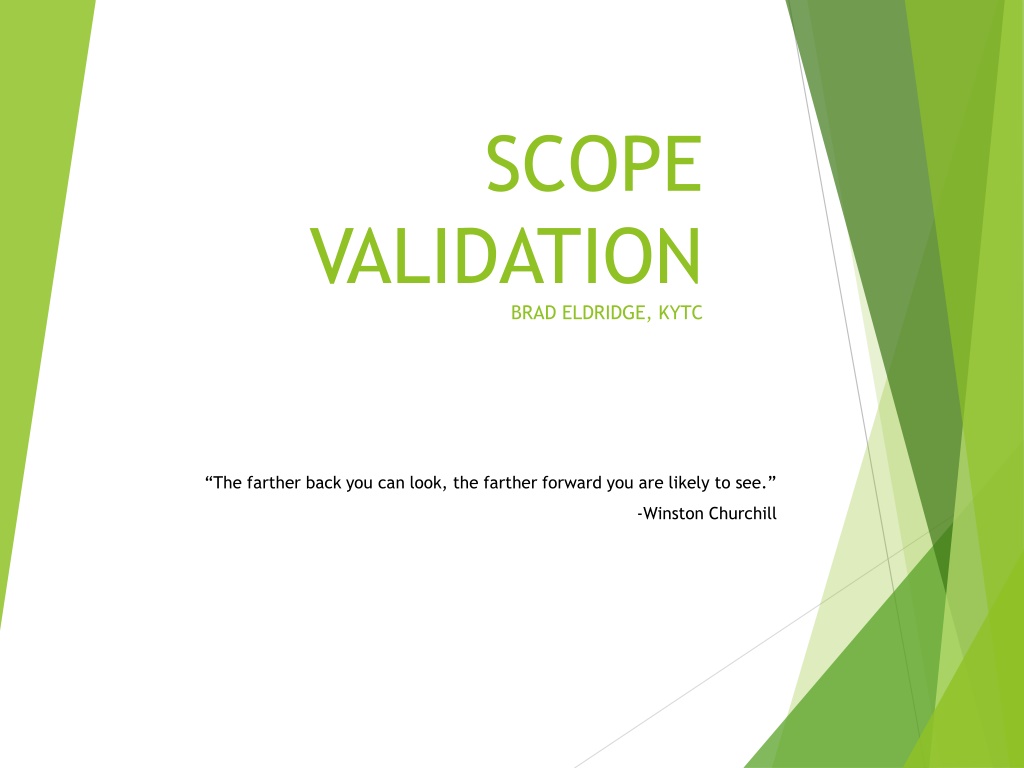Project Scoping and Validation for Successful Project Management
Project scoping involves gathering information, defining key design parameters, and identifying features to meet stakeholder requirements. Validating the project scope helps prevent scope creep and changes, leading to cost reduction and shorter schedules. Steps include resource determination, data gathering, and pre-design meetings to ensure a clear purpose and need statement. Utilizing statistical evidence, project scoping is crucial for effective project management.
- Project Management
- Scope Validation
- Stakeholder Requirements
- Resource Determination
- Efficient Planning
Download Presentation

Please find below an Image/Link to download the presentation.
The content on the website is provided AS IS for your information and personal use only. It may not be sold, licensed, or shared on other websites without obtaining consent from the author. Download presentation by click this link. If you encounter any issues during the download, it is possible that the publisher has removed the file from their server.
E N D
Presentation Transcript
SCOPE VALIDATION BRAD ELDRIDGE, KYTC The farther back you can look, the farther forward you are likely to see. -Winston Churchill
Project Scoping Involves getting information to start a project, and identifying the features the product would have in order to meet its stakeholder s requirements. A series of project-focused activities that develop key design parameters and other project requirements.
Pitfall of Inadequate Scope Over come negative impact of scope creep and scope changes
Benefits of Project Scoping Statistical Evidence indicates that earlier and more detailed scoping efforts can reduce total design and construction cost by as much as 20% and shorten total design and construction schedule by as much as 39%. (NCHRP Report 821- Effective Project Scoping)
Steps to Validating Scope Sche d. & Est. Scop e Resource Determinat ion Project Data Gathering Pre-Design Meeting Purpose Specific Data of Needs Data Gathering PROJECT INITIATION Draft P&N Projec t Scope
Project Data Highway Information View & Extract Interface, HIVEi Right of Way Preliminary Budget Existing Geotechnical Information Planning Studies/DNA As-built/Record Plans Utilities Traffic data Agency Coordination Crash data Modal Considerations Project Mapping
Pre-Design Meeting Draft Purpose and Need Additional Mapping Project Scope Environmental Overview Schedule and Milestones Traffic Forecasting Additional Resources Public Involvement
Purpose and Need Statement Is the first decision point of the shared decision process. Provides the foundation and framework for determining which alternatives will be considered and for selecting the preferred alternative. Contains factual and objective data and information on the statement of the current conditions and why the project is being pursued.
Developing a Project Scope Type of Project Proposed Access Control Project Description Possible Funding Types Draft Purpose and Need Potential Environmental Actions Roadway Characteristics Right of Way Requirements Potential Options to Consider Number of Drainage Structures Anticipated Utility Requirements Design Criteria
Results of Scope Validation Draft purpose and need General concept of what project should accomplish (and will not) Potential impacts and associated risks Baseline scope of work, cost, and schedule
BY FAILING TO PREPARE, YOU ARE PREPARING TO FAIL. -BENJAMIN FRANKLIN

 undefined
undefined






















